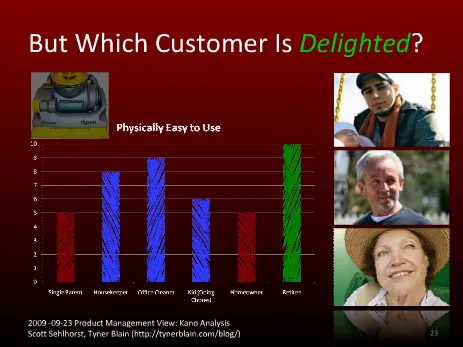You Don’t Know Jack (or Jill)
Blog: Tyner Blain

You’ve got some shiny new segmentation data about prospective customers; how much they earn, where they are located, how old they are. How does that help you make decisions about your product? You know this information, but you don’t really know your audience, or why they might become your customers.
Customer Needs Are A Function of Intent

Last month we looked at a single example of a customer expressing their wants instead of their needs – as most customers do. The main point is to keep in mind, that what a customer “wants” is really the satisfaction of a need – which reflects an intent. In last month’s example, the desire to sort a list is really a reflection of a need to select healthy food items, arising from an intent to be healthy.
This perspective is useful when thinking about your product, and questioning / prioritizing investment in particular features. Collecting these individual “what is the underlying goal?” insights informs your understanding of your market.
When you don’t know your customer’s intent, you don’t know your customer.
Kano for Product Managers

I did a presentation in 2009 for the Product Management View, on applying Kano analysis as a product manager. Kano helps you understand the nature of value associated with features and incremental improvements in features. Good stuff.
As a product manager, the main benefit of using this approach comes from appreciating that any given feature – like ease of use of an upright vacuum – will be of greater or lesser importance to different users.
Combine these two ideas (understanding the underlying goal, and realizing that different users value that goal differently) to get an understanding of what is important to whom, and why. This definitely helps, but still leaves you with a bit of a mess, as you realize that not everyone wants every thing.
Segmentation Based On Intent

On a walk the other day, I was listening to Brian Shea‘s interview with Susan Baier of Audience Audit, who really hit the nail on the head. Susan helps agencies understand the intent of their client’s customers and prospects. In the interview, Susan describes this in terms of attitude, opinions, and motivations. My inner monologue was rattling off intent, goals, context, jobs-to-be-done. Different language, describing the exact same thing. This is a great listen for any product manager or marketer, who is responsible for, or relies upon, an understanding of their market.
Susan provides a great example, describing work she did for one of her clients, in helping them understand the customers for scented candles. Check out the interview if you want more specifics, but here’s one aspect I remember (paraphrasing, and all mistakes are mine):
Some people buy scented candles because the aroma helps them manage their mood (relaxation / aromatherapy). Their intent, when making a purchase decision, is to become relaxed – and duration of scent is an important criteria for satisfying their needs.
Some people buy scented candles because they are decorating. Their goal is aesthetic – and often they would desire a completely unscented candle, because it is part of an ensemble achieving a particular appeal, and introducing an additional scent would detract from the appeal.
Some people buy scented candles as gifts for others. Their buying choices are influenced by the packaging (“Oh what a lovely gift!”) and the brand perception (“Wow, you really splurged, getting me ‘the best,’ thank you!”) because their job is to give a great gift.
All three of the people above could make $120,000 per year, be 43 years old, and live in the same subdivision; they could all be (otherwise) identical members of any demographic analysis.
This is exactly the kind of thing that matters for us as product managers.
Companies Have Identities Too
I’m not talking about the corporation as a legal “person” thing we do here in the USA. Companies are driven by goals and intents. I’ll save a discussion of Bowman Clocks for another post, and for now will contrast two hypothetical companies.
Two companies are competing in the hair-cutting market. They are both opening chains of salons, but there is a big difference in terms of the strategies the companies are pursuing – specifically, “who” the companies are trying to be. One company is trying to be the best low-cost and low-value provider (cheap cuts). The other company is trying to be the best high-cost and high-value provider (a pampered experience). Both companies need to do many of the same things, and each company will value different investments differently.
Just as different candle-buyers have different goals, so do these hair-cutting businesses. Imagine you’re selling software to these hair cutters, and you need to know what to prioritize for the next release of your software.
- The low-cost salon would love to reduce the time spent scheduling appointments – maybe you could build an online reservation / check-in capability. This increases their throughput and/or reduces their cost structure.
- The high-value salon would love to “remember” how best to pamper their clients on return visits, so building out some capabilities for the stylist to surreptitiously glance at his phone and “remember” that Fifi the Pomeranian is recovering from surgery. This increases their word-of-mouth referrals by improving the customer experience, allowing them to grow their customer base or charge higher prices.
While the concept of identifying intent-based personas is easy to describe in terms of individual consumers (B2C), it applies just as effectively when companies are your customers (B2B). Don’t make the mistake of assuming that intent only matters for consumer products.
Connecting the Dots
When we connect the dots from the sections above, to create a successful product, you must solve the right problems for the right users. Intent is a useful lens for identifying users (or buyers) who will value the same solution to the same problems.
Intent-based market-segmentation drives a tighter, better product.
That’s it in a nutshell. Thanks again Brian and Susan for inspiring this article.